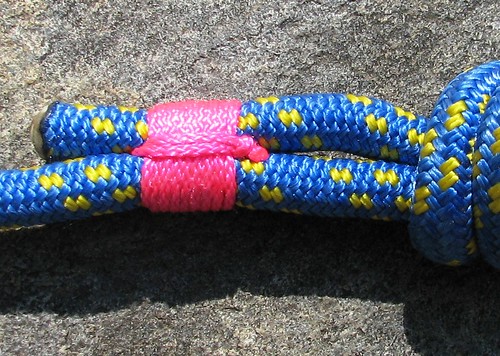For some time now I have been interested in testing 8mm Bee-Line, the very popular hitch cord made by Yale Cordage. This rope has a loose 12-strand hollow-braid core of vectran and a tightly braided 24-strand cover of a polyester/technora blend. Several knotted and spliced configurations were tested, including two eye-and-eye (e2e) split tails commonly used by climbers. I was assisted in this effort by a generous donation of gorgeous spliced and knotted ropes by our own Canopyboy.
The picture shows the four rope samples supplied by Canopyboy.

From left, an e2e with two locked Brummels each secured with a whipping. Next an e2e with two locked Brummels and no whipping. The two on the right are, except for their short length, production models ready for use: first a standard spliced e2e with locked Brummels at each end, about 5 inches of bury, and a whipping securing the cover ends; lastly an e2e with eyes formed with double fisherman's knots.
Some people may wonder why the tails of the locked Brummels are left exposed in the two ropes at left. This is to isolate the performance of the Brummels. If the tails were buried, then we would have a combination of Brummel and a splice. Several experiments on isolated splices (no Brummels) are also reported.
The picture shows the four rope samples supplied by Canopyboy.
From left, an e2e with two locked Brummels each secured with a whipping. Next an e2e with two locked Brummels and no whipping. The two on the right are, except for their short length, production models ready for use: first a standard spliced e2e with locked Brummels at each end, about 5 inches of bury, and a whipping securing the cover ends; lastly an e2e with eyes formed with double fisherman's knots.
Some people may wonder why the tails of the locked Brummels are left exposed in the two ropes at left. This is to isolate the performance of the Brummels. If the tails were buried, then we would have a combination of Brummel and a splice. Several experiments on isolated splices (no Brummels) are also reported.






